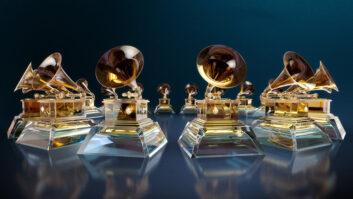Bunny Brunel’s reputation as a virtuoso fusion bassist wascemented with the lightning solos and solid timekeeping he laiddown for band leaders Chick Corea and Herbie Hancock nearly twodecades ago. A native of Nice, France, Brunel has fleshed out hiscareer with session work and teaching, which he conducts in hisL.A. studio and through his Cyber Bass lessons program, availableonline at bunnybrunel.com.
In February, Shrapnel/Tone Center Records released CAB2, a follow-up to the successful initial CD that Brunel wroteand produced with fellow band-members Tony MacAlpine(guitars/keys), Brian Auger (B3) and drummer Dennis Chambers. Withthe exception of the rhythm tracks, which were recorded at WarpStudios, the entire album was tracked, mixed and mastered atBrunel’s project studio.
No stranger to project studio recordings, Brunel recordedMomentum in 1986 using a Yamaha QX1 sequencer and an Akai1212 analog 12-track. “The quality of that recording stillholds up,” says Brunel. Today, Brunel’s studio centers aroundtwo MOTU 2408 interfaces, running on a Mac G4, and his Mackie D8Bconsole. “I started out with Performer, and after havingtried all of the other sequencers, I have stayed with it. DigitalPerformer has great timing and excellent wave-form editing tools,and it interfaces best with the 2408s.
“I’ve recorded with Pro Tools quite a bit — thebasics on CAB 2 were recorded to Pro Tools and thenbrought into my computer as SD2 files. If you have 30 grand tospend, you’ll get a good, stable system. My experience with morepared-down Pro Tools systems has been less successful. I find theDigital Performer/2408 combination to be extremely powerful andvery stable.”
Still, running native requires a console, according to Brunel.“You need to have a board, otherwise you’ll encounter latencyproblems when you start getting deep into the track count. TheDP/2408/D8B combination is perfect.”
CAB 2 was mixed entirely within Brunel’s digital systemwith excellent results. Low-end material, especially Chambers’ kickand thundering tom rolls and Brunel’s lines, is well rounded. Thestereo image is wide, and guitar overtones are nicely captured.When we spoke, Brunel had just installed Mackie’s new 3.0 Consolesoftware update and several UFX cards, which adds third-partyplug-in support. “Version 3.0 is the best,” chimesBrunel. “To me, the D8B sounds very much like a Neve console— very warm. Other comparable digital boards tend to have asmaller sound. The first thing I noticed about 3.0 is that Mackie’scorrected the problems they had with the gates and compressor.Also, the Drawmer compressor is fantastic, and the Massenburg EQ isoutrageous.”
Bernie Torelli mixed CAB 2, relying heavily on theWaves Renaissance compressor, particularly on the bass and guitartracks. Another Waves plug-in, Maxxbass, was applied to both thekick drum and bass parts.
Most of the cuts on CAB 2 required 24 to 32 tracks,which go from his DP, through the 2408s and into the 24 Lightpipeinputs on the board. Torelli and Brunel decide which tracks canmost effectively be processed within DP and group these as stereopairs to the board. The 8-channel Alt I/O card was used as returnsfor the DP echo returns. If more returns were required, thenTorelli used the analog outs on the 2408 to bus into analog inputson the D8B. “This combined approach, using plug-ins both inPerformer and on the board, works very well.”
Completed mixes, living on both the Mac and D8B, are then busedas a stereo mix to two additional DP tracks. Stereo mixes are savedas SD2 files and mastered in Pro Tools. “Bernie likes thecompressors in his Pro Tools systems. We pay a lot of attention togetting all of the dBs we can out of tracks before we master. Thatmakes the process easier.”
After 30 years in the business, Bunny Brunel is still an eagerstudent of technology. “I’m amazed at some of the gear that’sout there today. The Line 6 Prod Bass pod, for example, has themost amazing preamp I’ve ever tried. You can put all the cheese youwant on your bass — distortion, flanger — and the soundstays perfectly clean! We’ve also recently upgraded our Tannoymonitoring system to the System 800A-powered Dual Concentrics, witha PS350B subwoofer. The fundamentals sound so good! The quality ofproduct you can turn out in project studios just keeps gettingbetter and better.”
Gary Eskow is a contributing editor to Mix.







